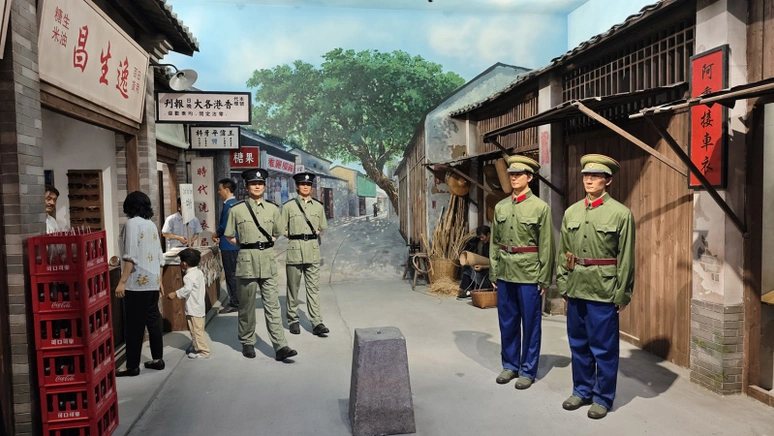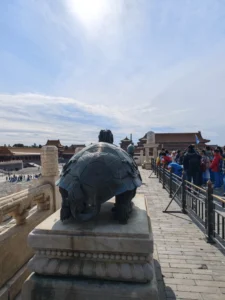After spending two days each in Beijing and Shanghai, our next destination is further south in China: Shenzhen. The distance between Shanghai and Shenzhen is 1,494 kilometers, which we travel by plane. As soon as we step out of the airport, we are struck by the wave of heat and humidity. It feels as though we’ve descended to tropical shores, a stark contrast to Beijing’s cold weather.
Shenzhen is a city in Guangdong province, located on the Pearl River Delta, with Hong Kong on one side and Macau on the other.
This is one of the Special Economic Zones of the People’s Republic of China. About 40 years ago, this place was a small fishing village, and its residents were impoverished, with many fleeing to Hong Kong. However, it has undergone extraordinary development, transforming into a hub of skyscrapers, finance, and high-tech production. Iconic Chinese brands like Huawei and OPPO were established here. Shenzhen is, in many ways, a symbol of Reform and Opening Up.
A 770,000-Square-Meter Paradise
Shenzhen is a sea of bougainvillea. The roses we saw along the streets of Beijing are replaced by vibrant bougainvillea in the south. Driving through this pink spectacle, the heat makes its presence felt immediately.
Our first visit is to the headquarters of HONOR, a technology company specializing in smartphones. The company showcases impressive technological innovations, such as foldable screens and multi-screen connectivity that allows seamless work across devices. This system, particularly beneficial for journalists, speeds up productivity significantly.
After leaving HONOR, we take a short break at Shenzhen Talent Park to recover from the journey’s fatigue. This park is like a green haven amidst towering skyscrapers. Spanning 770,000 square meters, it offers lush greenery, where people relax, sunbathe, and enjoy family time. Birds emerge from the water and glide gracefully in the sky.

Theater Above the Sea
Our evening features a boat tour. Boarding at a large harbor, we sail into the sunset, passing small and large islands along the way. After about an hour, we encounter a long, serpentine bridge stretching across the horizon: the Hong Kong-Zhuhai-Macau Bridge. At 55 kilometers long, the bridge has three sections, four artificial islands, and an underwater tunnel. Illuminated with blue, red, and orange lights, it offers a visual feast.
Onboard, Chinese artists perform theatrical shows, while some passengers choose to savor the sea, the evening, and the moonlight from open decks. Though we couldn’t fully understand the performances, we watched part of the show while sipping green tea on the way back.
Looking Down from 562 Meters
Our second and final day in Shenzhen starts with a visit to the Ping’An Finance Centre. At 115 stories and 599.1 meters tall, it is China’s second-highest building, boasting an observation deck at 562 meters. The elevators ascend so quickly that it feels like being launched by a rocket—but without the sensation.
From the top, Shenzhen lies beneath your feet. On one side, there’s the blue sea; on another, skyscrapers; elsewhere, sprawling green parks; and mountains reaching for the sky in the distance. Even looking down can make you dizzy.

Testing Stones While Crossing the River
Our final stop is the Shenzhen Reform and Opening-Up Exhibition Center, a key site for
understanding China’s transformation.
At the museum entrance, there are displays of rice collection machines, spinning wheels, employee identification documents, and stamped notes used before the reform era. One section features a path split in two, symbolizing the division between Shenzhen and Hong Kong. On one side, Hong Kong’s vibrant shops from the past are depicted, while on the other, Shenzhen’s closed shops reflect its previous underdevelopment. Adjacent to this, a representation of the current state shows no difference between the two.

One photograph catches our attention: an elderly official listening to a young man in the background. The young man is Xi Jinping, and the elder is his father, Xi Zhongxun, a key figure in the reform process.
The museum also includes a bull statue similar to the one we saw in Shanghai, symbolizing perseverance and hard work. Behind it, a tree root propels the bull forward.
Through displays of daily life, workshops, arts, bicycle culture, traditional attire, wooden ships, porcelain figures, and advanced technology, the museum paints a vivid picture of the region’s journey.

It also showcases revolutionary slogans like: “Testing stones while crossing the river,” “No step back,” and “Time is money, and efficiency is life.”

From Red Sorghum Fields to Flowers of Freedom
Though our time was limited to three cities, we observed some common themes. First, China is among the world’s safest countries, and this sense of security is evident among its people. Second, economic development has brought prosperity, positively affecting societal psychology. The streets, markets, and traffic exude a sense of calm, and most people appear cheerful. Security and economic progress seem to have instilled a sense of ease in society.

Women are prominent and self-assured, reflecting their growing equality in the country. Every guide and liaison we encountered was a woman—confident, bold, and disciplined in their work.
Chinese Nobel laureate Mo Yan’s Red Sorghum portrays three generations of women from 1923 to 1976, during the Resistance War against the Japanese invasion. Once oppressed like those sorghum fields, today’s women stand tall, producing and leading everywhere from fields to factories. The Communist Party’s significant achievement is nurturing these flowers of freedom, who now carry the nation’s development on their shoulders.
A Gastronomic Wonderland
China boasts a rich culinary heritage, dominated by seafood but also offering ample vegetarian options.
Chinese people enjoy communal dining, with rotating tables allowing everyone to share dishes. Meals are always accompanied by tea, particularly jasmine tea. Halal restaurants and Uyghur cuisine are widely available. The hot pot culture, reminiscent of a cook-it-yourself style, is also popular.
Western fast-food brands like Starbucks and burger chains have proliferated, but traditional beverages like lemon water and tea remain staples. Emerging brands like HeyTea compete with Starbucks, offering innovative drinks like matcha coffee and milk tea.
While dairy products are limited, unique desserts like mango-based treats offer a delightful culinary experience.
China, of course, cannot be fully understood in just a few days or cities. But we aimed to share the philosophy of the Chinese revolution and glimpses of daily life with our readers.
Türkiye and China have much to learn from each other. As two ancient civilizations with millennia of statecraft and cultural history, they should forge stronger relations. The Silk Road is once again uniting us in the rising Asian century. Now is the time to combine our material and spiritual strengths.
*This article retrieved from aydinlik.com.tr
Source: https://www.aydinlik.com.tr/koseyazisi/40-yilda-yaratilan-mucize-shenzhen-geri-adim-atma-496898




